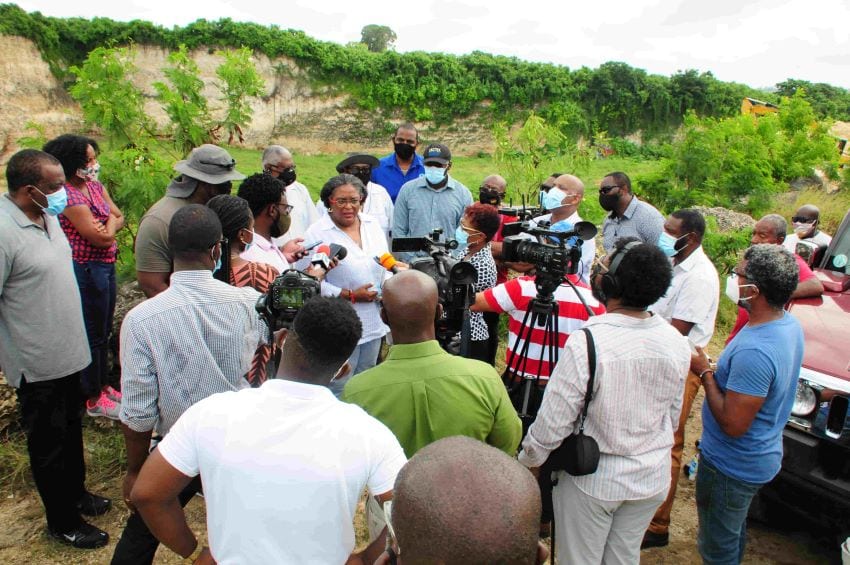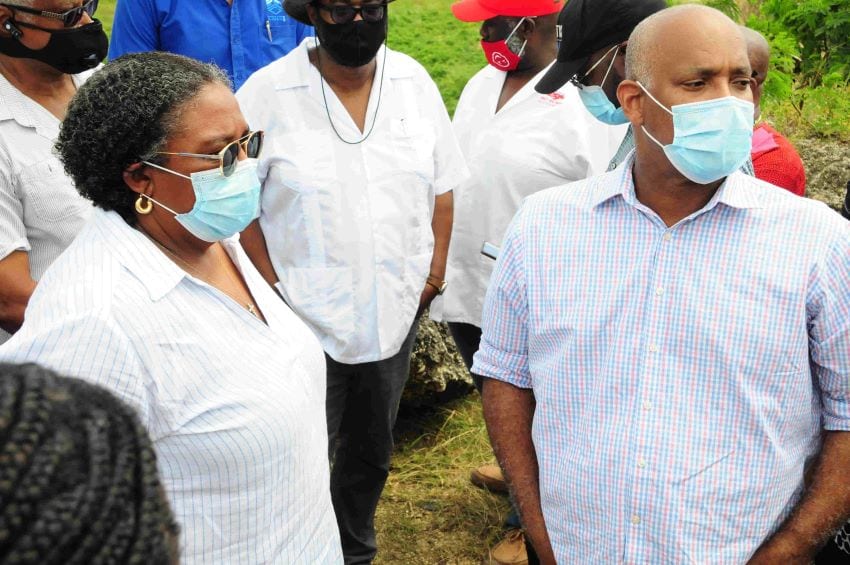
Government remains committed to solving issues relating to the dump at Lower Estate, St. George and today officials outlined how the matter will be tackled going forward.
Prime Minister Mia Amor Mottley; Attorney General, Dale Marshall; Minister of Health and Wellness, Lt. Col. Jeffrey Bostic; Minster of Environment and National Beautification, Adrian Forde, and several senior government officials toured the site.
Ms. Mottley said the matter was of grave concern to the Government and gave the assurance that it would be dealt with.
“This has been a matter on which we have been unwavering…. We would not be asking the Pan American Health Organization to send an independent person to deal with this if we were not serious about being held to account, not just for the sake of the Government, but for the benefit of the residents.
“If we were not serious about it, we would not have … others on the committee that has been dealing with this issue. So, this has been an inclusive approach from the very first day by the Government,” she stressed.
Describing it as a public nuisance, Attorney General Dale Marshall said the matter had been drawn to the attention of the entity that was responsible for the dumping, and disclosed that he was in the process of preparing a remediation agreement.
“We’ve already had discussions on it, and that remediation agreement will provide the legal basis without having to go to court, because that is an option, but at this point in time I don’t think that there’s any reason why we need to pursue court action against the entity, in as much as he has in fact admitted the wrongdoing, and more importantly, has verbally agreed to take the steps that are required.
“So, from my position as Attorney General, I have the responsibility of putting that legal framework in place. I expect to be able to do that within the very next week or two and that framework will set out all of the required actions,” he explained.
Mr. Marshall stressed that Government was adamant that the polluter must carry every single bit of the cost of remediating the area.
Minister Bostic, who chairs the inter-ministerial sub-committee that was formed, said Cabinet papers had been prepared, committees had been established, including a technical committee which already held several meetings and made site visits.

He added that the recommendations made had been examined very closely and another Cabinet paper produced, which outlined the way forward.
“Regrettably, … COVID-19 delayed the progress of things, and I apologise to residents for that because some of the principal players, including Mr. [Ronald] Chapman, who is also the head of the COVID-19 Monitoring Unit and myself as the chair of the inter-ministerial committee, … could not give all of our time and efforts to this particular situation because of COVID.
“But we are back on track. The paper was submitted. We have a plan as to how we are going to deal with it. I reached out again to the Pan American Health Organization, and they have agreed to assist us with a specialist, out of Washington D.C., to deal with air pollution, for example, in the area because that is a particular expertise that we felt we needed to get, along with the equipment that is required…,” he stated.
Chair of the technical committee, Ricardo Marshall, said the issue would be addressed in three sections – solid waste management, water and water quality and air quality.
With regard to solid waste management, Mr. Marshall continued: “What we have proposed to do is to excavate along the north and the eastern wall… to a depth of about 10 feet, and away from the wall, another 15 to 20 feet. We are going to then do some compaction of what is under there and we are going to put clay along the walls of the quarry so that you create that clay liner, which would prevent the movement of air and water into the cell….
“Secondly, in the area of water and water quality, we are putting a monitoring programme in place to be able to understand whether or not there’s any movement of material from here that could be a threat to the ground water. So, we have to put that monitoring programme in place, and we will be doing that through a series of new bore holes, as well as existing wells that can already be sampled.”
He noted that the third component had to do with air quality and reiterated that Government would be getting assistance in that area from PAHO.
